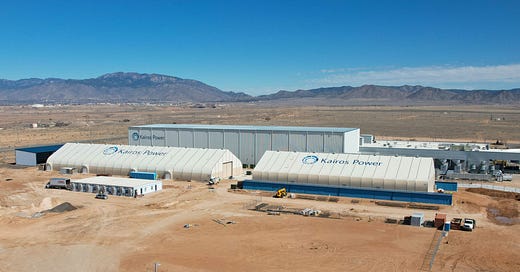It’s “nuclear renaissance” time again.
Every so often, America’s economic, political, and cultural elites get it in their skulls that Our Friend the Atom is on the cusp of a dramatic rebirth. In 1991, Time claimed that nuclear was “gaining new respect” — with humanity worried “about global warming and acid rain, even some environmentalists are looking a bit more kindly on the largest power source that doesn’t worsen either problem.” Fourteen years later, BusinessWeek wrote that “economics” and “fears of global warming” had “nukes … on the verge of a comeback.”
Yet the rebound never arrives. Nuclear’s contribution to U.S. electricity generation peaked, at 20.6 percent, in 2001. Market share fell to 18.2 percent in 2023, and with no commercial plants, or even reactors, currently under construction anywhere in the country, improvement is not on deck anytime soon.
But niggling things like facts don’t deter states’ apparatchiks of “economic development.” Corporacrats follow buzz and trends more closely than teenage girls, and right now, nuclear is hot. Bipartisan giveaways from Washington started the vibe shift. In 2021, the “Infrastructure Investment and Jobs Act” secured “$6 billion … to prevent premature retirement of existing zero-carbon nuclear plants.” Last year, the feds went further — the ADVANCE Act will empower the nation to “build new reactors at a clip that we haven’t seen since the 1970s.” And the U.S. Department of Energy boasts that nuclear power got “off to a fast start in the first 100 days of the Trump Administration.”
Is it any wonder that small modular reactors are all the rage, and tech bros are planning big additions to America’s atomic-energy infrastructure?
No energy hype ever escapes the notice of politicians, bureaucrats, and activists who enjoy meddling in the marketplace. So the laboratories of democracy are racing to reward the nuclear industry:
• Everything is bigger in the Lone Star State — including corporate welfare. State Rep. Cody Harris, a Republican, envisions a “Texas Advanced Nuclear Energy Office,” tasked with overseeing “nuclear energy initiatives, funding programs, and regulatory assistance in the industry,” establishing “a workforce development program to train the next generation of nuclear professionals” and creating “a new funding program … to provide reimbursement grants for project completions.” His bill passed the House with massive bipartisan support, and awaits action in the Senate.
• Just over the border, in deeply Democratic New Mexico, the state and the City of Albuquerque are handing Kairos Power $3.5 million for construction of its Salt Production Facility. The company is “focused on the delivery of a clean, affordable and safe energy solution through the integrated design, licensing and demonstration of advanced reactor technology.” (The Land of Enchantment’s giveaway is richly ironic, given that Kairos Power “opened its Albuquerque location in 2020” on the site of a subsidized solar-panel factory that went bust — and laid off 250 workers — in 2012.)
• Michigan lawmakers are considering a tax credit “equal to 15% of the claimant’s qualified research and development expenses incurred … related to advanced nuclear reactor technologies,” a tax credit “equal to $1 for each kilowatt hour of electricity” generated “using small modular reactors,” and a “Nuclear and Hydrogen Graduate Attraction and Retention Program … to provide a grant program for certain postsecondary graduates who are employed at a Michigan facility that uses nuclear or hydrogen technology to generate electricity.”
• In Wisconsin, a GOP solon thinks his state can become “the Silicon Valley of next generation.” He wants the Public Service Commission to conduct a siting study for fission and fusion plants.
• At the close of this year’s legislative session, Tennessee’s Republican governor swooned over the appropriation of “$50 million to create the Small Modular Reactor … Grant Fund,” $10 million in additional “investment in the Nuclear Energy Fund to attract advanced nuclear technology companies,” $2.6 million for “the nation’s first regulatory framework for commercial nuclear fusion power,” and $10 million in fresh revenue for the “Governor’s Investment in Vocational Education … to support nuclear workforce education, as recommended by the Nuclear Energy Advisory Council.”
Electricity generated by uranium (and a fair amount of plutonium) is wondrous. The process is clean, efficient, and safe. And with the right investors, scientists, engineers, and regulatory structure, nuclear plants might power the nation one day. But don’t count on “incentivization” from state governments to hasten the process. If anything, boondoggles are inevitable.
Energy, Richard Feynman warned, “is a very subtle concept,” and “very, very difficult to get right.” The Nobel winner’s humility is sorely lacking in state capitals.





Until the regulatory process is streamlined, it is not going to happen. New Mexico are bound to fail in this quest since the whole set up would be to enrich their buddies. Too many dreams and too many failures in this state (RailRunner, Spaceport, and ART are just three examples).
I had not even heard of the Salt Production Facility in NM. Past subsidized projects such as Eclipse Aviation, Spaceport and the various solar manufacturing companies have brought so many lobs to NM that I'm sure this one will be no different. To repeat what has been said many times before, after nearly 90 years of single party Dem rule , NM is such an unattractive place to do business that many businesses will only come if bribed with taxpayer subsidies to do so.